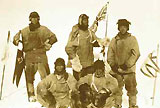History of the huts
At the turn of the nineteenth to the twentieth century, teams of men raced to explore Antarctica, bidding to be the first to reach the South Pole in what became known as the heroic era of Antarctic exploration.

Scott's Polar Party at the South Pole. © Antarctica New Zealand Pictorial Collection
The Antarctic Heritage Trust focuses on the legacy left by 4 major expeditions, led by Norwegian Carsten Borchgrevink, Robert Falcon Scott (who led 2), and Ernest Shackleton .
The teams' objectives were to collect scientific data and to be the first to travel deep into the continent, exploring plateaus, volcanoes and wastelands where no one had been before, with the ultimate goal of reaching the South Pole.
Shackleton's 1907-1909 expedition, when he built the Cape Royds hut, saw his team turn back just 156 kilometres from the pole (the furthest south anyone had been at that time). They were also the first to make the ascent of the world's southernmost active volcano - Mount Erebus .
The conditions under which they lived were appalling - isolated, freezing and with no hope of rescue in the event of disaster. Their diaries and records describe the beauty of the environment, the horror of their conditions and the courage of the explorers.

